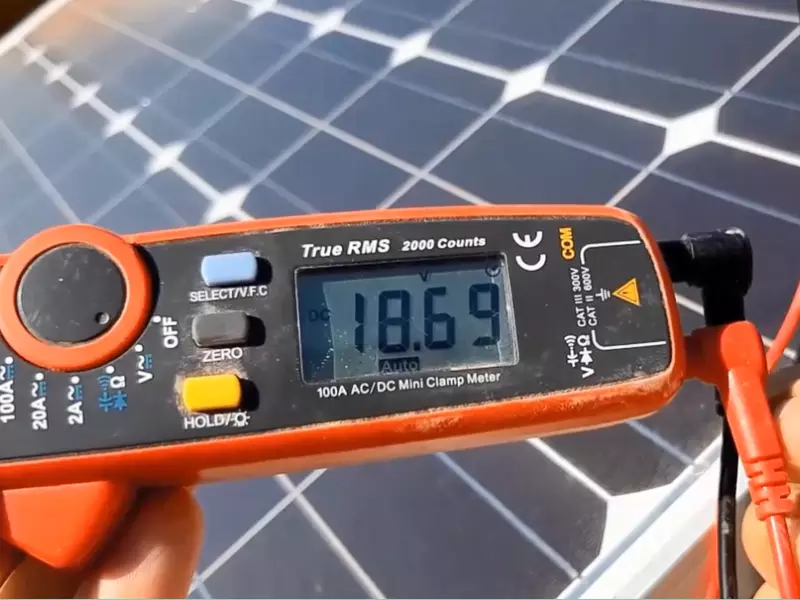Solar panels have emerged as a prominent renewable energy source in the face of escalating environmental concerns. Harnessing sunlight to produce electricity, they work silently while reducing dependency on conventional power sources. However, a fundamental part of understanding solar panels is recognizing the role of voltage within these systems.
These seemingly simple devices convert sunlight into electricity, generating a certain voltage that is often higher than required by most home appliances or electrical systems. Typically, a standard solar panel produces around 30 to 40 volts, which is significantly more than the voltage required for common household use. Therefore, managing and reducing the voltage of a solar panel is crucial to ensure safety and efficiency.
This discourse will delve into how voltage plays an integral role in the functionality of solar panels, explaining the technical aspects in a comprehensible manner. From the interplay between volts, watts, and amps to detailed methods of reducing the voltage of solar panels, we aim to shed light on these concepts and much more. Let’s explore together.
Basic Concepts: Volts, Watts, and Amps
Before diving deeper, it’s crucial to understand the fundamental units of electricity. Volts (V) represent the potential difference, the ‘push’ that moves electrons through a wire.
The term Amps (A) or amperage, refers to the current, signifying the flow rate of electricity. Lastly, Watts (W) embody the rate of energy transfer or the power, determined by multiplying volts and amps.
These units do not exist in isolation and are intrinsically connected through the power formula, P = V x I, where P stands for power in watts, V for voltage, and I for current in amps. In other words, the power output of an electrical system is the product of its voltage and current.

Standard Voltage Production in Solar Panels
General Overview of Solar Panel Voltage Output
A standard solar panel, under ideal conditions, generates a voltage output of approximately 30 to 40 volts. However, the actual voltage production depends on several factors including solar panel design, the amount of sunlight received, and the panel’s temperature.
Factors Influencing the Voltage Output of Solar Panels
Key factors influencing voltage include:
- Sunlight Intensity: The amount and intensity of sunlight directly affect the voltage output. More sunlight translates into higher voltage.
- Temperature: Solar panels tend to perform better in cooler conditions. High temperatures can lead to a decrease in voltage.
- Panel Design: The make and model of a solar panel can significantly affect voltage production. Different panels are designed to produce different voltage levels.
Converting Volts to Watts and Understanding Amps
Process of Converting Volts to Watts
Given the power formula (P=VI), to calculate watts, simply multiply the voltage by the amperage.
Role of Amps in Conversion
Amperage is crucial in these conversions as it indicates how much electricity is flowing from the solar panels. A change in amperage directly affects the total power output measured in watts.
Practical Examples of Conversions
Let’s assume a solar panel producing 36 volts at 5 amps. Using P = VI, the power output would be 36V x 5A = 180 watts.

Why Do We Need to Reduce Voltage from Solar Panels?
Reducing voltage is often necessary because most residential and commercial electrical devices operate at lower voltages. Operating these devices at high voltage can result in excessive heat and potential damage. Therefore, voltage management is a crucial aspect of a solar power system.
Ways to Reduce Voltage from Solar Panels
Solar Charge Controller
A solar charge controller is a key component in solar power systems that helps regulate the voltage produced by the solar panels. It ensures the voltage is suitable for charging batteries or powering appliances.
Solar Panel Configuration
Solar panels can be configured in series or parallel. A series configuration increases the voltage, while a parallel configuration maintains the same voltage but increases the current. Therefore, a parallel configuration can be used to keep voltage at a desired level.
Use of Resistors
In some cases, resistors can be used to reduce voltage. They restrict the flow of electric current, thus reducing the voltage.
Choosing the Right Equipment for Voltage Reduction
Selecting the right solar charge controller and resistors is crucial to manage voltage effectively. It’s recommended to consult a solar energy expert or a reputable supplier to choose the equipment that suits your solar power system’s needs.
FAQ Section
What is the ideal voltage for a home solar power system?
Most household appliances operate at around 110-120 volts. Therefore, a home solar power system should ideally be designed to produce this voltage.
Does a higher voltage mean more power output from my solar panel?
Not necessarily. Power output is a product of voltage and current. Therefore, a high voltage with a low current may not result in high power output.
Can I manually adjust the voltage output from my solar panels?
Yes, but it’s a complicated process and requires expertise. It’s recommended to get assistance from a solar power professional.
Conclusion
Solar panels, while an excellent source of renewable energy, do present challenges with voltage management. Understanding the role of volts, amps, and watts in electricity generation, and the factors influencing solar panel voltage output is key.
To adjust voltage to desired levels, solutions like solar charge controllers, strategic panel configurations, and the use of resistors are available. It’s paramount to choose the right equipment that complements your system’s needs. Remember, while exploring solar energy’s potential, it’s also crucial to ensure the longevity and safety of your solar power systems.
